Rudolph Ackermann’s journal, The Repository of Arts, is likely already familiar to Jane Austen fans for the fashion plates if nothing else. Functioning as something we might call a lifestyle journal today, its full title was The Repository of Arts, Literature, Commerce, Manufactures, Fashions, and Politics—with a change in 1816 to The Repository of Arts, Literature, Fashions, Manufactures, &c.—and it covered all these areas and more. This article is partly an introduction to the people responsible for The Repository, through the lens of some less well-known content that will be illuminated: its music reviews from 1809–1816, the working lifetime of Jane Austen. Throughout the twenty-year run of The Repository of Arts, from 1809 to 1829, its monthly music reviews analyzed scores for domestic music-making rather than concertizing. While the focus here is on 1809–1816 rather than on the entire run, these earlier issues illustrate some intriguing connections between domestic music and events on the world stage, allowing for some conclusions about emotional affinities on the part of domestic performers. These reviews cover the ending years of the Napoleonic Wars and the period during which Jane Austen wrote Emma (her most musical novel), and Persuasion. Far from dull, as some musicologists accuse it of being, the music reviewed in The Repository was created and marketed for specific reasons. Often inspired by the remarkable events of the time, this music provided its home performers with an important, personal connection to Britain’s place in world events.
Rudolph Ackermann
We cannot cover any part of The Repository of Arts without starting with Rudolph Ackermann, the remarkable entrepreneur responsible for every aspect of The Repository throughout its run. Ackermann was born 20 April 1764 in Stollberg, near Leipzig, then in the Electorate of Saxony, and a great center of publishing and printing (including music) as well as famous book fairs (Ford, Rudolph Ackermann and the Regency World 28). He was the sixth child of Barthel Ackermann, a saddler and carriage-maker, and his wife Susannah (11). Rudolph studied at the Latin school at Stollberg and then at Schneeberg, where his family moved in 1775. The Oxford Dictionary of National Biography article on Ackermann, courtesy of biographer John Ford, lists an extraordinary number of accomplishments that are well worth perusing in their entirety; due to space and subject constraints, only a few of the most relevant details are highlighted here.
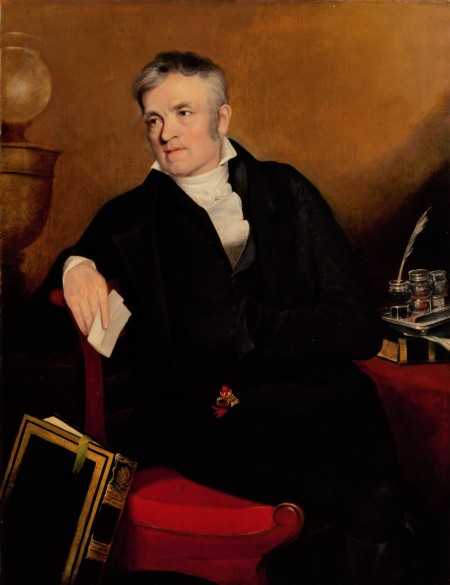
Rudolph Ackermann, attributed to François Nicholas Mouchet, oil on canvas (1814). © National Portrait Gallery, London
This painting, almost certainly commissioned for Ackermann’s fiftieth birthday given its date, tells us a great deal about the man himself. Surrounded by a sumptuously bound elephant folio, no doubt of one of his own publications, and hints of other accoutrements of fashionable living, he looks elegant but a bit tired, though clearly working through his fatigue with that note in his hands. Since much of his Repository editorial work was carried on through correspondence from across the country and, eventually, the world, the note may well be related to the journal. Robert Darnton tells us that early-modern London reporters, or “paragraph men,” turned in their news and gossip on scraps of paper just like this one (260). Ackermann is wearing black: certainly not a Beau Brummel dandy, but almost a proto-Victorian, Ackermann’s black is relieved only by that snowy cravat and gold and red seal fob. Almost Romantic, that weary figure.
And he had reason to look tired. At the age of fifteen Ackermann was apprenticed to his elder brother Friedrich, a saddler with artistic leanings who tutored Rudolph in drawing and engraving as well as carriage design. Ackermann remained interested in artistic pursuits for the rest of his life, despite his eventual career in printing and commerce. He arrived in England in 1787, at twenty-three years old, where he designed many high-end carriages for the rich and famous of the time, including a state coach for George Washington. (It’s interesting to note this lone but significant American connection, as the Repository music reviews don’t mention America at all, even during the war of 1812.)
Ackermann networked with other émigrés from the Electorate of Saxony, as he did quite successfully throughout his life, most significantly with engravers for leading print publisher John Boydell. He was also an active Freemason (Ford, Regency 4). London at the end of the eighteenth century was a thriving center of German printers (see Jefcoate). The importance and influence of Ackermann’s early connections with Boydell’s Saxon draftsmen and engravers cannot be overstated. He eventually settled in large premises at 101 Strand (known as “The Repository of Arts” from 1798) in 1797.
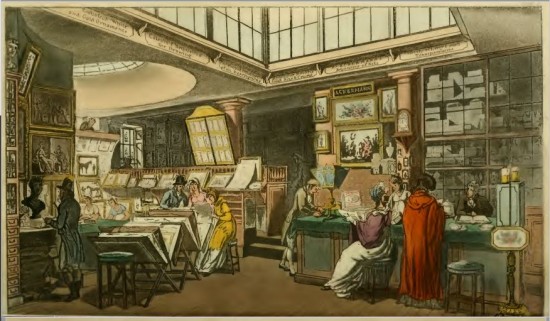
The Repository of Arts, 101, Strand, by Augustus Pugin and Thomas Rowlandson. Repository of Arts (January 1809).
(Click here to see a larger version.)
The title of Ackermann’s journal came from this gallery, which handled prints and paintings, fancy papers, and high-end watercolor paints, which Ackermann manufactured specially. Ackermann continued designing carriages throughout the early growth of his commercial printing activities. In 1808–1810 he published The Microcosm of London, which continues to be an invaluable source of Georgian and Regency London imagery. The Repository of Arts journal began in January 1809, and on 24 March 1809 Rudolph Ackermann became a naturalized citizen of the United Kingdom. He continued to publish lavishly illustrated books, as well as music and individual prints, throughout the run of the journal.
In 1816, after an introduction from a mutual friend of the inventor Alois Senefelder (inventor of the lithography process), Ackermann established the first significant lithographic press in England and played an important part in popularizing lithography by publishing Senefelder’s 1818 treatise Vollständiges Lehrbuch der Steindruckerey in English in 1819, translated by that very same mutual friend, Antonin Schlichtegroll. The use of lithography in art and music was a huge step forward for commercial production, creating efficiencies which allowed for high quality publications at greatly reduced costs, and Ackermann was one of the first to benefit.
Eventually, a lifetime of overwork caught up to him, and in 1830 he had a serious stroke, followed by paralysis. In October of 1832 he turned the business over to his younger sons, had a second stroke in November 1833, and died 30 March 1834, in his London home. He was buried at St. Clement Danes burial ground, 7 April 1834. Though born a Lutheran, Ackermann had eventually joined the Church of England, which surely provided additional avenues of networking. Despite such evidence of assimilation, he spoke with a strong German accent throughout his life and, in his work and social associations, maintained close connections with transplanted Germans and Austrians. While the partnership of Ackermann & Co. was dissolved in 1855, the separate print business of his eldest son, Rudolph, survived as Arthur Ackermann & Son and continued under that name until 1992, when it merged with another fine art dealer to become Arthur Ackermann and Peter Johnson Ltd. Few companies established in the 1790s have survived so successfully to today. Ackermann’s remains a testimony to its founder.
The Repository music reviews
Ackermann’s Repository of Arts was issued 1809–1828 in three series: 1809–1815, 1816–1822, and 1823–1828. A new series was announced in the December 1828 issue, but R. Ackermann’s Repository of Fashions only seems to have run for nine volumes in 1829. The journal began in January of 1809, featuring fashion, social, and literary news, and included 1432 hand-colored plates throughout its run. In many ways the culmination of Ackermann’s commercial enterprises, The Repository brings together his vision of a life well-lived (for those who can afford it, or who aspire to), a Germanic culture of nascent Romanticism, and a support of strong moral values, all of which found a receptive audience in the Hanoverian ruling family and the large German population in England. Ackermann’s Germanic point of view eventually supplanted more robust Enlightenment values in his publications, presaging England’s increasingly high moral tastes as it moved into the Victorian era. The Repository provided the occasional plate devoted to music-related furniture, as well as cunningly designed fortepianos, music stands, cabinets, etc. Ackermann and general editor Frederic Shoberl (W. P. 112) clearly believed that music should be a part of every well-curated Repository life. As Ackermann himself noted, “his business would not deserve to be called The Repository of Arts if it did not bring an offering to the harmonic muse” (Ford, Regency 129).
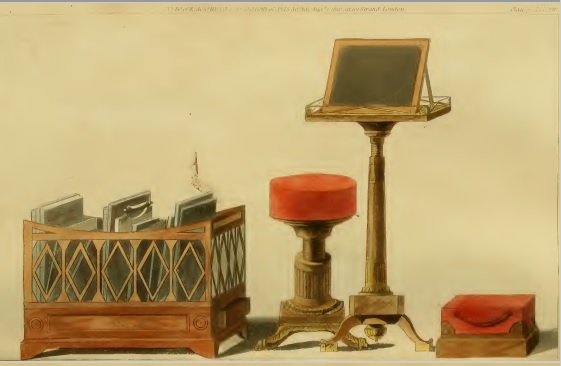
Furniture for a music room, including a footstool for guitarists. Repository of Arts (August 1815).
The “Musical review” section followed a fixed format throughout the print run, comprising an italic header with title, composer and arranger, dedicatee, and price, followed by the body of the review itself. As the convention of the time dictated anonymity, the reviewers are never identified in print, allegedly to allow them to share their views more freely (Olleson 1098–99). Identifying writers in newspapers or journals of this period can be a nightmare, but we are fortunate that Gottlieb Lewis Engelbach is outed in the 7 August 1869 Notes and Queries article on Rudolph Ackermann (112). Engelbach is also identified by Samuel Wesley (composer, son of Charles Wesley, and nephew of John Wesley of Methodist fame) in his correspondence (Kassler and Olleson 299); as a frequent music reviewer himself, Wesley was certainly in a position to know (Olleson 1100).
Gottlieb Lewis Engelbach was born 29 September 1775, in Bouxwiller, Alsace, France, but lived in London by the time of his marriage 26 September 1797 (Watson Family). As his status as Repository reviewer was anonymous, he’s best known for the publication of letters he wrote during his grand tour, first published serially from 1809–1813 in The Repository of Arts under the title “Letters from Italy,” then separately under the title Naples and the Campagna Felice: in a Series of Letters, Addressed to a Friend in England, in 1802. This work was published in a lavishly illustrated edition by Ackermann in 1815 and included illustrations by Thomas Rowlandson. The Gentleman’s Magazine lists Engelbach as dying 1 June 1852, in Darmstadt, Hesse, “formerly of the Audit Office, Somerset House” (109). The Audit Office provided oversight of public spending for Parliament (“History of the NAO”). It is difficult to imagine working a day job and still turning out up to twenty-four reviews month after month for twenty years, so no doubt he had some assistance. Information about his education has proven elusive, but he appears to have been raised as a gentleman, which would imply that he had some music education; his command of the repertoire is impressive indeed.
Engelbach’s reviews generally outline the merits of the music, chiefly somewhat favorably, rating their difficulty, providing corrections to printing or compositional errors, and occasionally “educating” young composers; most intriguingly, he also highlights historical context where appropriate. Unfortunately, he rarely indicates the publisher until later in the run, unless it is Ackermann. This omission causes a serious problem, given all of the piracy and reprinting going on at the time, as in some cases it is impossible to ascertain the publisher of the actual imprint seen by Engelbach. His tone is overall quite readable if flowery to a twenty-first-century reader. Submissions were openly invited: “New musical publications also, if a copy be addressed to the publisher, shall be duly noticed in our Review” (January 1816, verso of contents). No doubt publishers also submitted scores, though this was never stated openly. As is evident in the quotation above, submissions went through Ackermann (as publisher) first, an important point and a reminder that Ackermann was at the center of everything to do with The Repository. It is difficult, however, not to question Engelbach’s impartiality. In an August 1810 review, he asserts: “As in the present, and probably in the succeeding numbers of the Repository, our critical functions will have to be employed on musical works published by the proprietor of this magazine, we think it right to assure our readers, that our judgment is fettered by no injunction, or even hint, on the part of the publisher, or by any motives of sordid servility which could infringe the impartiality of our pen” (103).
Had The Respository been accused of “motives of sordid servility”? The only stated reason for exclusion was those submissions which would “reap neither amusement nor instruction,” as stated in the February 1816 issue (verso of contents), but many of the same composers are featured repeatedly. Also, since Ackermann always saw the scores first, no doubt anything he recommended regarding choice of piece or content of review was a given, despite Engelbach’s assertions of independence (Ford, Ackermann, 1783–1983 79).
Here is a breakdown of the top fifty or so composers from 1809–1816, with the number of their reviews.
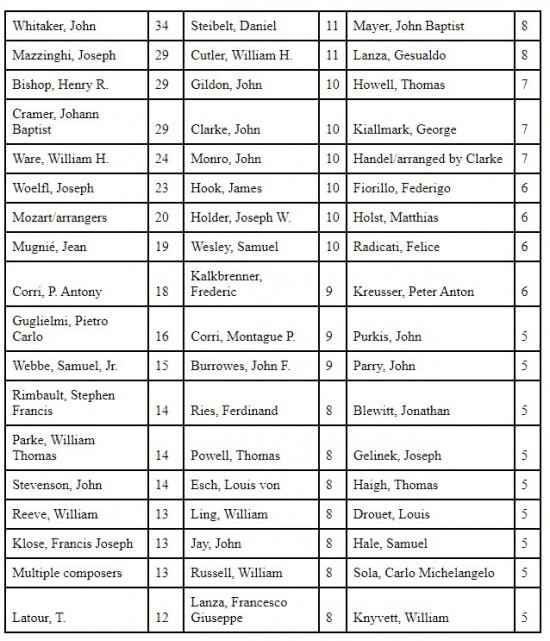
Mozart, for instance, shows up with twenty reviews to his credit, by various arrangers. Engelbach often mentions Mozart as a master of good composition when “educating” new composers, or women. His flowery language sometimes disguises condescension, for example, when reviewing Caroline Kerby in September 1816: “Like the literary labours of the fair sex, which, generally speaking, produce rather what is called light reading than subjects of profound meditation, Miss K.’s rondo before us steers perfectly clear of any thing which could be deemed bordering on the higher and scientific walks of composition” (168). Jane Austen would no doubt have something to say about this comment. Out of 977 reviews in the eight years covered, there are only eighteen reviews comprising works by thirteen women composers. This was quite disheartening to confirm—however expected—given the women composers found in Grove Music who were active in England at the time. It raises the question of whether their music was being actively overlooked by Ackermann or Engelbach, or if they simply weren’t submitting copy to The Repository.
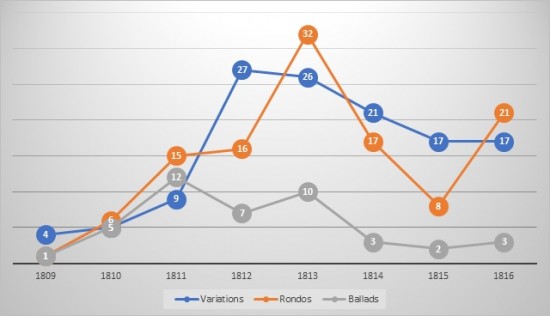
Comparison of variations, rondos, and ballads.
(Click here to see a larger version.)
Breaking down the genres and instrumentation as a part of the project allowed for some surprising discoveries. An example of what is possible in this kind of analysis: comparing the growth in the variation and rondo forms reviewed, with the waning of the ballad form. As Philip Olleson writes in “Samuel Wesley and the European Magazine,” “Leanne Langley described music in Victorian England as a ‘dark and weedy patch in the garden of European music,’ traditionally avoided by music historians. . . . Although Langley’s remarks were particularly aimed at the 1820s and later, they are also relevant to the first two decades of the century” (1097). It is the prevalence of “empty” virtuosity that prompts a good bit of this criticism —an accusation leveled even more vehemently against the opera of the period. In the comparison of review numbers above, we see the soulful (Sensible) ballad gradually losing ground before the rise of more virtuosic forms of variations (in music, variations comprise a structure in which a theme is repeated several or many times with discrete modifications each time) and rondos (the rondo is a structure consisting of a series of sections, the first of which recurs, in an ABACAD . . . A sequence).
As another example of the wealth of hidden information contained in these reviews, an interesting discovery was the number of Robin Adair versions published between 1812 and 1816. Janeites will no doubt remember that Robin Adair is named in Emma in an unidentified arrangement for the piano, when Jane Fairfax plays a version on the infamous gift of a Broadwood fortepiano, and Emma discusses it with Frank Churchill (262). John Braham introduced the tune of Robin Adair with new words on 7 December 1811 at the Lyceum Theatre with the Drury Lane company (their theater having burned down), and it became an instant hit (“Lyceum” 3). Being able to date publications reliably is important, since music from this period is rarely dated on the actual score: the appearance of reviews in The Repository helps to fix their publication dates, as well as providing a glimpse of how quickly composers moved to exploit a popular tune.
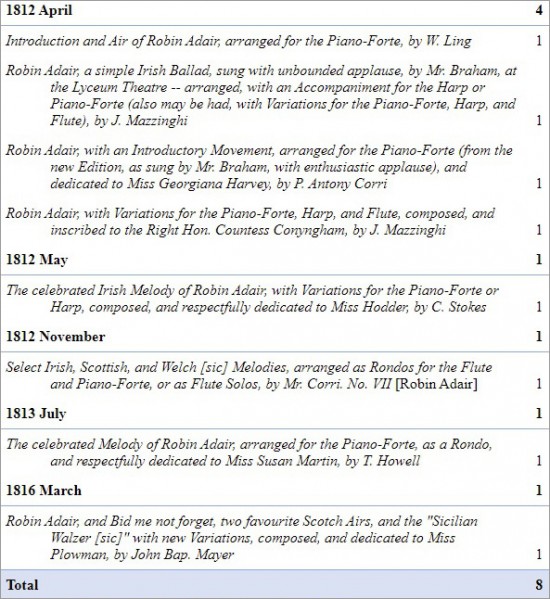
Versions of Robin Adair reviewed between 1812 and 1816.
A Kiallmark arrangement for piano (not reviewed in The Repository) is the probable candidate for Emma, since it appears in a bound volume of music signed by Jane Austen’s sister “Cass. Elizth Austen” on the front flyleaf, now owned by Richard Jenkyns (Kiallmark). As Kathryn Libin remarks, “this version is playful and challenging, perhaps more suited to Jane Fairfax’s mettle than a simple harmonized setting of the song would have been” (21). We can see that several versions were reviewed in 1812, the likely date of the Kiallmark score (its paper is watermarked with that date on the British Library copy). But it is certainly worthwhile to see how many other options Austen might have had in mind.
Music reflecting current events
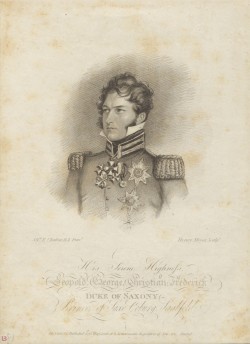
Prince Leopold of Saxe-Coburg, by Alfred E. Chalon; engraved Henry Meyer (July 1816). (Click here to see a larger version.)
Just as publishers did with sheet music throughout the nineteenth and twentieth centuries, music publishers during the Regency featured current events wherever they could, because they sell copy. An unnamed waltz with only an opus number from the composer, to be published in 1814 for instance, might be given a title like The Leipzig Waltz by the publisher in reference to the Battle of Leipzig, just for the recognition factor. The Repository reviewed many pieces of this ilk without much commentary. The marriage of Prince Leopold of Saxe-Coburg to the Prince Regent’s daughter Charlotte comes immediately to mind, particularly due to the Repository portrait of Leopold: artist Alfred Chalon was justly famous for bringing out the attractiveness in his subjects, and he certainly succeeded here in this July 1816 print. Chalon’s early portraits of Disraeli, Robert Peale, and Prince Albert are almost feminine in their beauty.
Leopold inspired no less than five pieces reviewed between May and November of 1816; he was clearly a topic of great interest (and potential music sales) to the public:
- The Prince of Saxe Cobourg, a favourite Dance, composed and arranged as a Rondo by M.P. Corri (May 1816)
- His Royal Highness the Prince of Coburg’s Grand March, composed and arranged for the Piano-Forte by A. Voight (June 1816)
- Non felicior alter. Festa Epitalamica Pastorale per le Reggie Nozze di S.A.R. la Principessa Carlotte di Galles, col Serenissimo Principe di Sassonia Coburgo, le Segnenti Composizioni sono umilmente dedicate a S.A.R. il Principe Regente, a S.A.R. la Principessina Carlotte di Galles, ed al Serenissimo Principe Leap. di Sassonia Coburgo, da loro umili e fedeli Servitori Leucippo Egineo, et dal Cav. Marescotti (August 1816)
- The Saxe-Coburg March and Waltz for the Piano, composed by S.F. Rimbault (October 1816)
- Saxe-Cobourg, a Rondo for the Piano-Forte, composed by A. Beezwarzowsky [Beczwarzowsky] (November 1816)
Saxe-Cobourg, a Rondo for the Piano-Forte
composed by A. Beezwarzowsky [Beczwarzowsky]; reviewed November 1816.
Performed by Stephen Alltop on a modern fortepiano built by R. J. Regier of Freeport, Maine.
(Click here to listen.)
While Leopold serves as an excellent example of how some current events were reflected in Repository music reviews without particular notice from the reviewer, such references do provide us with valuable information about such details as how long it takes to bring a particular event to publication (as we’ll see below). And such references are invaluable in assessing the breadth of contemporary reaction to a given event. But those pieces concerning the Napoleonic Wars inspired far more emotional outpourings from Engelbach.
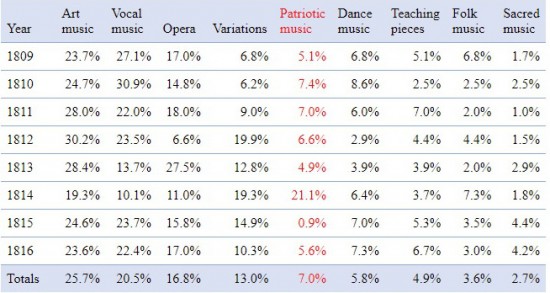
Musical genres: percentages by year
(Click here to see a larger version.)
Parsing out the review data involved assigning each piece a genre: art music (generic pieces like sonatas and divertimentos), dance music (which includes ballet), folk music, opera (comprising any dramatic music), patriotic music, sacred music, teaching pieces, variations (numerous enough to merit their own genre), and vocal music (anything sung that wasn’t opera; chiefly songs or ballads, and glees). Throughout the course of analyzing these reviews, for purposes of simplicity, titles expressing devotion to the nation in any way, or dedicated to a national figure or even an unknown soldier, were considered “patriotic,” as were military pieces dedicated to a specific regiment or battle. The prevalence of patriotic music waxed and waned, comprising over 21 percent of all of the reviews in 1814, but dropping down to less than one percent in 1815, evening out to seven percent across all of the reviews. Some of the uneven numbers between 1814 and 1816 may stem from the delay in the publication of a work connected to actual events.
Event and date, Repository review dates
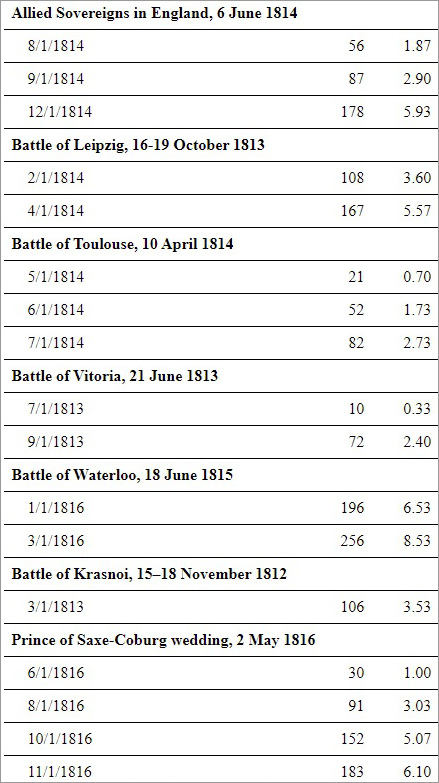
Days/months between selected events and review publication
The average amount of time across the patriotic music for the news of an event to reach England; for a composer to be inspired and then complete a piece; for the publisher to print their manuscript; for the score to reach Ackermann and then to be assigned to Engelbach; to be assessed, and the review written, reviewed by Ackermann and then printed was 146 days (adjusted for extreme outliers), which is to say 4.9 months. All things considered, that was quite swift, especially given the number of reviews published per month. Note particularly April of 1813 below, with a total of 24 reviews, a significant effort.
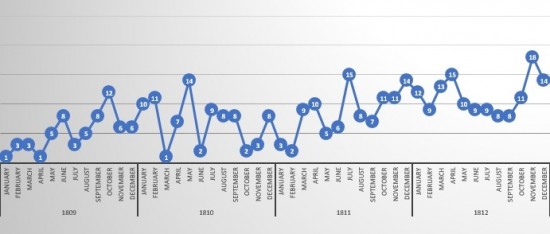
Number of reviews published by month, 1809–1812.
(Click here to see a larger version.)
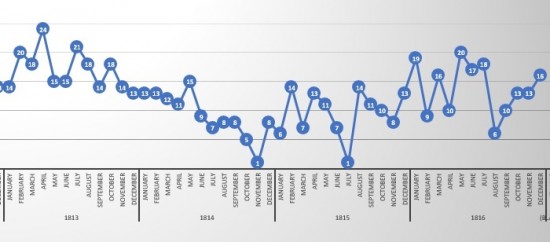
Number of reviews published by month, 1813–1816.
(Click here to see a larger version.)
The longest lag by far was 717 days, or almost two years, for Steibelt’s The Conflagration of Moscow to be reviewed after the event, which occurred in September 1812. But look at the entries above for the Battle of Toulouse: one review was published twenty-one days after the event. Given that this battle effectively ended the war—or so they thought—it is understandable that people capitalized on this news in every way, as quickly as possible.
Emotional connections in music reviews
Looking more closely at the actual review text on the more intense patriotic pieces reveals an interesting pattern. The first seriously patriotic review, in the August 1810 issue, sets the tone for Engelbach’s future commentary. The review of The Battle of Aspern, on the Danube, 22d May, 1809, in which the Austrian Forces under the Command of H.R.H. the Archduke Charles, totally defeated the Grand French Army commanded by Napoleon Bonaparte: a Grand Military Piece for the Piano-Forte, composed by J. W. (probably Joseph Woelfl) encapsulates Engelbach’s three most-repeated themes. First, Napoleon is an evil monster who must be beaten. Second, music composed in honor of great historical events is rarely criticized, and this benevolence is usually articulated by Engelbach in some way, as if to ensure that readers should know that he was deliberate in his generosity. And third, descriptive musical passages are often highlighted particularly, along with describing the emotions they evoke in the performer:
Such is our admiration of the hero whose glorious achievement gave rise to this publication, and our exultation at the happy prospects into futurity which this glorious display of his military superiority over the inflated vanity of his upstart antagonist, warrants us to entertain, that probably our political partiality would have induced us to treat with indulgence any composition intended to commemorate so important an event, were even its pretensions to our notice greatly inferior to the merits of this publication.. . . The “March towards the enemy” is a fine and spirited movement. The passage corresponding with the words, “the fight commences,” &c. are highly characteristic of the bustle of war, and finely relieved by some wild discords. The roaring of the cannon, the charge of the cavalry, platoon firing, &c. are well depicted by appropriate musical expression. The destruction of the French bridges, and, above all, the drifting down of the rafts and fireships, are most ably pourtrayed. The two bars rest for the words, “Napoleon meditates,” are eminently picturesque, and more expressive of the bulletin-monger’s disappointment and perplexity than all the notes the musical scale affords. They brought to our recollection the fine contrivance of a great painter, who, unable to depict an excess of grief in the principal figure of the group, painted him in the act of hiding his face, thus leaving the task to the imagination of the beholder. . . . A short andante, wherein “Germany and Europe thank their heroic deliverers,” concludes the whole. A more beautiful and affecting movement than this we have not heard for some time, at least not among the compositions of the present day. Its melody and harmony are well calculated to go hand in hand with those sensations of joy which every British heart must have felt at the welcome tidings of the first great humiliation encountered by the enemy of social order. (110, emphasis added)
The italicized passages highlight these three themes. Notice particularly Engelbach’s reference to how the “beautiful and affecting movement” goes “hand and hand with those sensations of joy which every British heart must have felt at the welcome tidings of the first great humiliation.” Right from the start, he associates music directly with the emotional response to a specific event. This connection is also emphasized by emotional rhetoric concerning the events themselves without reference to music.
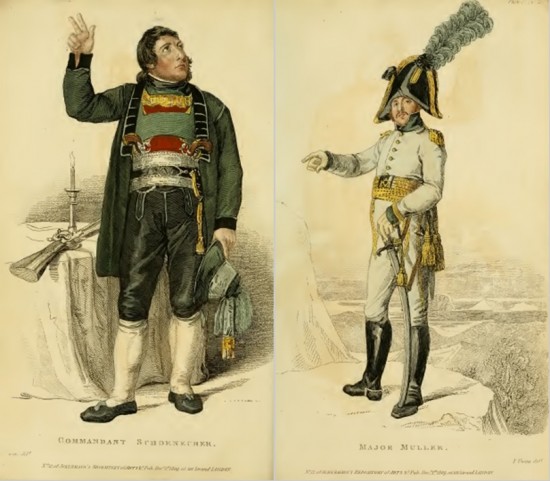
Tyrolese deputies (December 1809).
Engelbach also echoed news featured in earlier Repository articles. In 1809 issues from September (200) to October (273) to December (388–91), for instance, Ackermann had been running articles and even plates on the Tyrolean freedom fighters. In the February 1810 issue, Engelbach picks up this emphasis in his review of The Tyrolese March by Joseph Woelfl (composer identified by Ford, Regency 114):
To all those that have admired the heroic efforts of the brave Tyroleans, to assert the liberty of their country—and what Briton has not read, with a mixture of joy and astonishment, the narratives of the repeated successes obtained by those hardy and virtuous mountaineers over the flower of the French armies? (120)
This example illustrates another regular Repository feature: synchronicity between news coverage and music reviews. If the Bishop of Oporto gets an admiring article (among other references) with a portrait plate in the June 1810 issue (409–11), then it is not surprising to see the Portuguese March for the Piano-Forte, composed, and dedicated to the Bishop of Oporto, by J. Woelfl reviewed in September 1810, with similarly admiring rhetoric: “what British heart will not glow with admiration of the patriot, who, to defend his country’s cause, exchanges his mitre for a helmet, his crozier for a sword?” (172). Doubling down on the sentiments evoked by the events of the day serves to highlight Engelbach’s connection of readers’ emotional responses to those events, with topical music.
The Battle of Toulouse, and its aftermath of long-awaited peace, inspired The Allied Pleasures in Paris, composed for the Piano-Forte, and most respectfully dedicated to His Excellency Field-Marshal von Blücher, by Wm. Grosse, reviewed in June of 1814. Notice again how Engelbach’s prose paints a picture worthy of program music (music of a melodramatic or descriptive kind, though without sung text):
the whole of the coalesced forces lay aside their swords and spurs, and fall to dancing, every one according to his country’s fashion, either in a “Grand imperial Russian walz,” an “Austrian laendler,” a “royal Prussian walz,” a “Galloppade,” or a “Cossack” pas seul, and when the whole company have singly displayed their national dancing abilities, all join merrily in a “Toutes ensemble,” as the author terms it, . . . it would not be manners to look for an awkward step or two in the Russian or Austrian skipping, and thus disturb the Allied pleasures. The Prussians, as they fought best, here dance most to our mind. (344)
Again we see the heightened descriptive prose and sensitivity for the composer of such patriotic fare and notice that the Prussians fought best: no doubt Ackermann was happy with the reference to the valiant Germans. “It would not be manners to look for an awkward step or two”—comments like this one model those high moral values mentioned above.
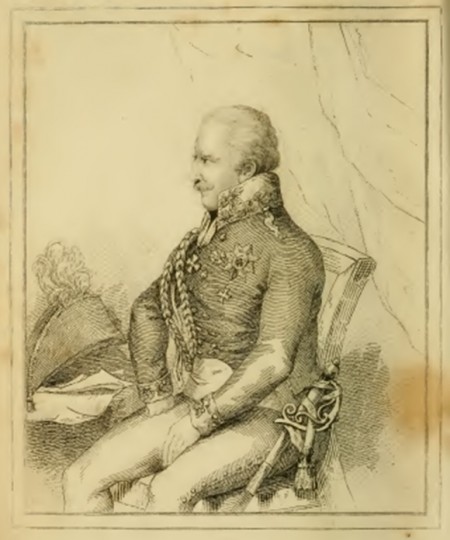
G.L. von Blücher, Field Marshal of the Prussian Forces from an original drawing by Her Royal Highness Princess Wilhelmina of Prussia (May 1814).
These heightened, affecting descriptions of music almost seem to imply that consumers will be transported emotionally when performing this music. The May 1814 Repository portrait of Field Marshal Gebhard Leberecht von Blücher (297) visually exemplifies this nascent Romanticism as well; at heart, we find Ackermann’s German sense of cultural heritage. With all the images of Blücher to choose from, Ackermann, who knew Blücher well personally (Ford, Regency 180) published a pose in profile that emphasizes Blücher’s Caesar-like nobility, visually harkening back to ancient coins1. Remember how closely Ackermann himself was involved with every part of the The Repository? His foregrounding in this portrait of the Field Marshal’s quiet valor is a part of that German influence mentioned above on the coming Victorian world, which Ford mentions in his biography (Regency 12) and in his Oxford Dictionary of National Biography article. It is no surprise that Engelbach then echoes Ackermann’s approach in his music reviews (“It would not be manners to look for an awkward step or two . . .”).
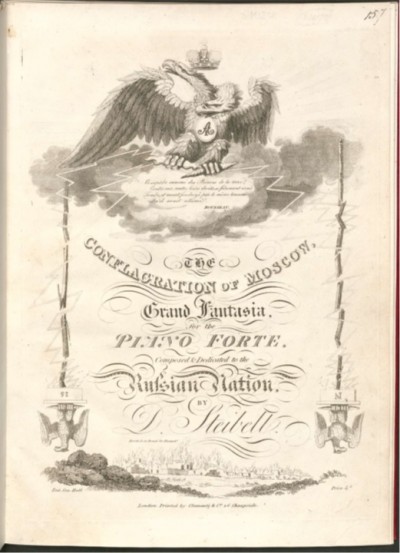
The Conflagration of Moscow, 1814. title page. Bavarian State Library. 4 Mus.pr. 32776.
The previously mentioned Conflagration of Moscow, grand Fantasia for the Piano-Forte, composed, and dedicated to the Russian Nation, by D. Steibelt, which took almost two years to bring to press, provoked a comment in September 1814 that perhaps brings us closer to what domestic consumers of this music may have enjoyed:
If it is possible, by a combination of musical sounds, to excite sensations analogous to those which human passions or striking events produce, the present attempt of Mr. S. may be affirmed to have accomplished that object with more truth, skill, and success, than any similar work we are acquainted with. (165)
Are music consumers indeed participating in world events from faraway corners of Britain, by exciting their senses musically? Romanticism definitely seems to be in the air; no more the heightened awareness of the self and others of Sensibility; these reviews imply that the primacy of the individual has arrived, as they seem to be aimed at the consumer as performer alone. Engelbach’s reviews bring out this tantalizing possibility so often that it seems clear that he viewed this emphasis on the passions as a major selling point.
The Siege of Badajoz
for the Piano-Forte, with Accompaniments (ad libitum) for a Flute, or Violin and Violoncello, composed, and inscribed to the Earl of Wellington and his brave Army, by J. Gildon; reviewed in September 1812.
Performed by Stephen Alltop on a modern fortepiano built by R. J. Regier of Freeport, Maine, with intertitles spoken by Josefien Stoppelenburg.
(Click here to listen.)
In February 1816, Engelbach reviewed The Surrender of Paris, a characteristic Divertimento for the Piano-Forte, including the events from the Duke of Wellington and Prince Blücher's marching to that capital, to the evacuation by the French troops and taking possession by the Allies, composed by Louis Jansen. He wrote that it
consists of a good number of movements descriptive of military manoeuvres, marches, attacks, &c. in the melodramatic style of composition. Among others, we have “Wellington and Blucher's grand march”—“Arrival of the news that the Allies are in sight”—“Hesitation of the Chambers what to do”—“Consternation of the inhabitants”—“March of the French to the heights of St. Cloud”—“Skirmishing, cannonading, swords, gallopping of horses, running fire,” and lastly “Cessation of hostilities.” After this comes a real musical curiosity, viz. a moderato, recording the eighteen articles of capitulation. . . . The words themselves, to be sure, are not added, and this omission prevents us from judging whether every feeling and sentiment has been correctly expressed. . . . This is carrying the picturesque in music to so great a height of perfection. (113)
And there it is. Have every feeling and sentiment been correctly expressed? Do we as performers feel drawn into the exciting sentiments of that “picturesque in music” enough to justify twenty-one percent of our entire music outlay in 1814? However simple the music itself may be, if this music indeed represents a “dark and weedy patch in the garden of European music” (Olleson 1097), perhaps that dark and weedy emotion is what domestic music-makers were seeking. Jane Austen was writing Persuasion between 1815 and 1816 (Persuasion xix), during the very period that some of these reviews were coming out. Would Austen have taken emotional connections with such music for granted? She might have imagined Anne Elliot interacting with music in this manner, though the expressed emotions of Anne’s musical interactions at Uppercross, and of the later concert scene, all relate directly to Captain Wentworth. But The Repository is persistent in suggesting that music transports the performer, and Anne Elliot certainly would have taken solace in this. For her, music is indeed a solitary experience: “She knew that when she played she was giving pleasure only to herself. . . . In music she had been always used to feel alone in the world” (50).2
Combine an endless war on foreign soil, with fathers, brothers, sons, and friends from so many households involved in the war efforts, and you can understand why their wives, children, siblings, and parents sought a personal, emotional connection to world events from which they were separated. Rudolph Ackermann and Gottlieb Lewis Engelbach understood this need, and were ready to help.
NOTES
1I’m indebted to Jeff Nigro for bringing this aspect of profile portraits to my attention.
2I’m grateful indeed to editor Susan Allen Ford for pointing out this specific connection to Persuasion.
